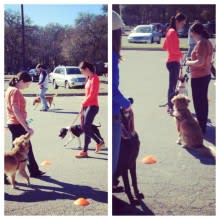 Dogs Out Loud class isn’t your typical “obedience” class. While we may incorporate Sits and Downs into our activities, we don’t hang our hats on long stays or a perfect heel. Our goal is getting dogs ready for and keeping them in their forever homes. A typical DOL class dog needs to work on boundaries, patience, focus or self-control.
Dogs Out Loud class isn’t your typical “obedience” class. While we may incorporate Sits and Downs into our activities, we don’t hang our hats on long stays or a perfect heel. Our goal is getting dogs ready for and keeping them in their forever homes. A typical DOL class dog needs to work on boundaries, patience, focus or self-control.
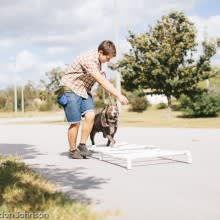 We do whatever it takes to a help a dog learn to self-calm and settle using kind, non-aversive methods. Our toolbox includes TTouch, Karen Overall’s Relaxation Protocol and Leslie McDevitt’s Pattern Games, Grisha Stewart’s BAT (Behavior Adjustment Training), myriad training games and set-ups to make learning fun for both dog and handler, plenty of freeform reinforcement that means listening to our dogs, a shabby obstacle course made out of some really weird stuff, Nina Ottoson puzzle toys, car rides, field trips, and whatever it takes to bring some sunshine and rainbows into a shelter dog’s life. But we found we needed a way to measure the impact these activities had on a dog’s behavior. How could we demonstrate to shelter staff and adopters what kind of progress a dog in our program had made? We found a pretty good measuring stick in the AKC’s Canine Good Citizen (CGC) Program.
We do whatever it takes to a help a dog learn to self-calm and settle using kind, non-aversive methods. Our toolbox includes TTouch, Karen Overall’s Relaxation Protocol and Leslie McDevitt’s Pattern Games, Grisha Stewart’s BAT (Behavior Adjustment Training), myriad training games and set-ups to make learning fun for both dog and handler, plenty of freeform reinforcement that means listening to our dogs, a shabby obstacle course made out of some really weird stuff, Nina Ottoson puzzle toys, car rides, field trips, and whatever it takes to bring some sunshine and rainbows into a shelter dog’s life. But we found we needed a way to measure the impact these activities had on a dog’s behavior. How could we demonstrate to shelter staff and adopters what kind of progress a dog in our program had made? We found a pretty good measuring stick in the AKC’s Canine Good Citizen (CGC) Program.
The CGC Program serves as a basis of every DOL project dog’s training plan as well as the foundation of our classes. According to the AKC’s information, the program was “designed to reward dogs who have good manners at home and in the community.” The CGC includes a 10-step test in which the dog must perform a series of skills that demonstrate good manners, self-control and willingness to follow direction from the handler even when distracted.
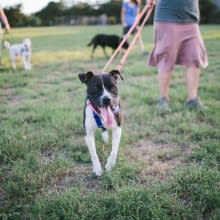 The Canine Good Citizen Program helps us objectively measure a dog’s success in class or their training plan and what they still need to work on. By working through each of the tests, we can show a new family where the dog is in his training and what he still needs to work on. DOL behavior consultant Steve DeBono explains why the CGC program is so helpful this way: “The best thing about CGC is that it is goal oriented, which is helpful for humans, who tend to see things in terms of concrete goals. I think it helps for the human to know what ‘success’ looks like.” Indeed, when our dogs sit politely to greet visitors or quietly pass by another dog when they would have reacted previously, it’s pretty easy to see what success can mean for that dog.
The Canine Good Citizen Program helps us objectively measure a dog’s success in class or their training plan and what they still need to work on. By working through each of the tests, we can show a new family where the dog is in his training and what he still needs to work on. DOL behavior consultant Steve DeBono explains why the CGC program is so helpful this way: “The best thing about CGC is that it is goal oriented, which is helpful for humans, who tend to see things in terms of concrete goals. I think it helps for the human to know what ‘success’ looks like.” Indeed, when our dogs sit politely to greet visitors or quietly pass by another dog when they would have reacted previously, it’s pretty easy to see what success can mean for that dog.
It’s a big benefit to adopters to take home shelter dogs who have had CGC training prior to adoption, and other shelters are jumping on board with the idea too. Austin Pets Alive! started their Canine Good Citizen Preparation Program in the summer of 2013 for similar reasons. “Through training, diligence, and one-on-one care, dogs who would otherwise be the hardest to adopt — or even euthanized in other cities — are now becoming adoptable, highly trained pets.”
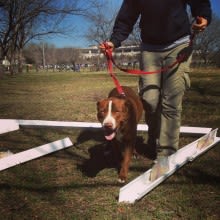 Post-adoption, it’s much easier to continue on with training that was started at the shelter than it might be to start training with a dog who has an unknown training background. Love-A-Bull, an Austin-area nonprofit promoting responsible ownership of pit bulls through education and advocacy, offers a Canine Citizen Program as part of their training offerings for adopters of pit-bull-type dogs. They believe “the CGC is just one way to show everyone that our dogs are exemplary members of the community, and to strengthen the bond between pittie and parent.”
Post-adoption, it’s much easier to continue on with training that was started at the shelter than it might be to start training with a dog who has an unknown training background. Love-A-Bull, an Austin-area nonprofit promoting responsible ownership of pit bulls through education and advocacy, offers a Canine Citizen Program as part of their training offerings for adopters of pit-bull-type dogs. They believe “the CGC is just one way to show everyone that our dogs are exemplary members of the community, and to strengthen the bond between pittie and parent.”
We’ve seen that benefit too. We break the tests into small segments of our classes, and our dog/handler teams truly enjoy the challenges of mastering the skills. Long term, the AKC CGC Program makes a great foundation for branching out into Agility or other dog sports, or can be helpful when trying to convince a landlord to accept your dog. For us, the CGC tests are a barometer for a successful training session and a way to have fun with our dogs.
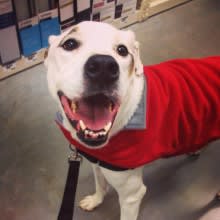 Though our dogs are not usually ready to take the CGC test before they go home, they have real world skills other shelter dogs may not have. This is a huge benefit to adopters because they already have a head start on a well-trained dog! For example, we practice politely greeting “strangers” at class (CGC Tests 1 and 2), and then we take that out in the real world with field trips to dog-friendly spots like Home Depot and Half Price Books. In class we practice walking on a loose leash (CGC Test 4) through a “crowd” (CGC Test 5) and how to handle unexpected and potentially frightening distractions like bicyclists, lawn mowing and loud vehicles (CGC Test 9). If a dog has a solid foundation of practicing these good behaviors, it makes neighborhood walks with her new family so much more enjoyable. A family can jump right in and establish a tight bond with their new dog, because we can show them what the dog knows how to do and what she still needs to work on. The family can then set reasonable expectations, jump into activities the dog is already comfortable doing, and avoid other activities she’s not ready for without some more training.
Though our dogs are not usually ready to take the CGC test before they go home, they have real world skills other shelter dogs may not have. This is a huge benefit to adopters because they already have a head start on a well-trained dog! For example, we practice politely greeting “strangers” at class (CGC Tests 1 and 2), and then we take that out in the real world with field trips to dog-friendly spots like Home Depot and Half Price Books. In class we practice walking on a loose leash (CGC Test 4) through a “crowd” (CGC Test 5) and how to handle unexpected and potentially frightening distractions like bicyclists, lawn mowing and loud vehicles (CGC Test 9). If a dog has a solid foundation of practicing these good behaviors, it makes neighborhood walks with her new family so much more enjoyable. A family can jump right in and establish a tight bond with their new dog, because we can show them what the dog knows how to do and what she still needs to work on. The family can then set reasonable expectations, jump into activities the dog is already comfortable doing, and avoid other activities she’s not ready for without some more training.
 The bottom line is, CGC training directly helps strengthen our relationship with our dogs. We establish that bond during the training. Because we know what she can do and what her limitations are, we have confidence that we can handle most situations and we know what to avoid for now. All this translates into more time spent having fun with our dogs, and less time feeling frustrated and wondering what to do. And all because the CGC Program gives us measurable objectives.
The bottom line is, CGC training directly helps strengthen our relationship with our dogs. We establish that bond during the training. Because we know what she can do and what her limitations are, we have confidence that we can handle most situations and we know what to avoid for now. All this translates into more time spent having fun with our dogs, and less time feeling frustrated and wondering what to do. And all because the CGC Program gives us measurable objectives.
For more information about how we use the AKC’s Canine Good Citizen Program to help shelter dogs, feel free to contact us. To help support our training programs, please donate and indicate that you want your donation used for for our shelter dog training program.
